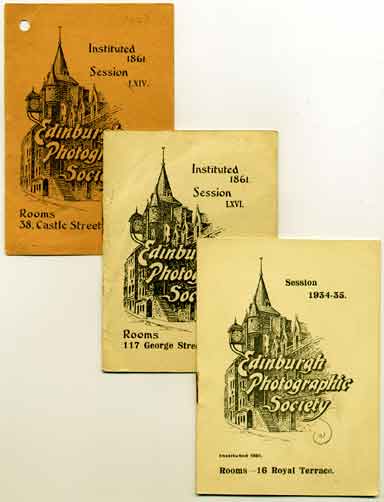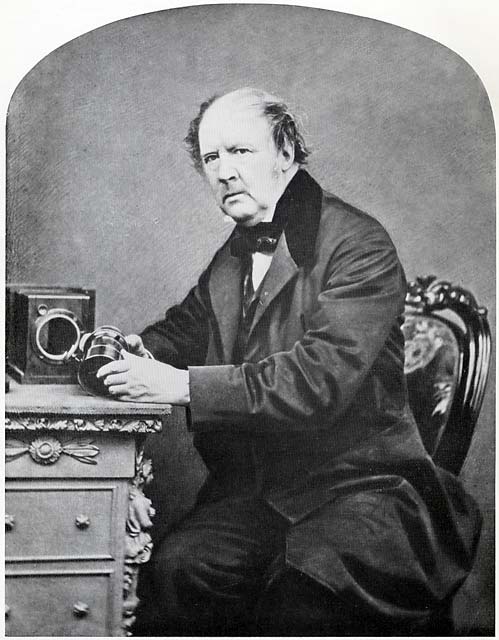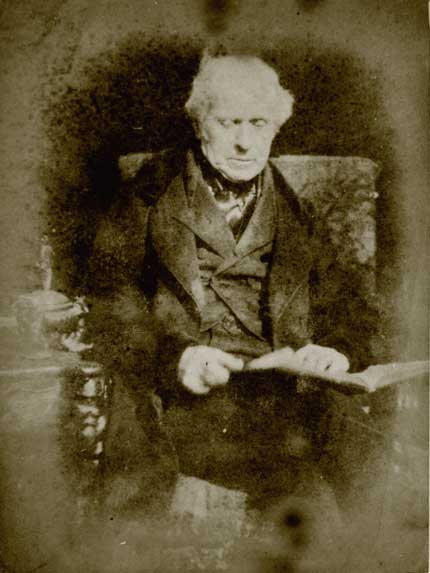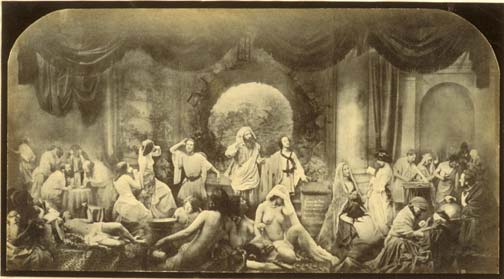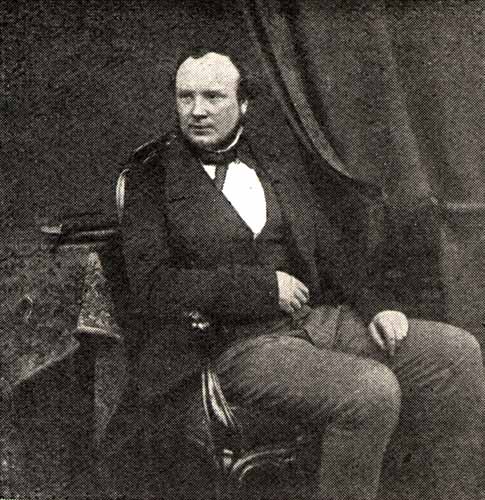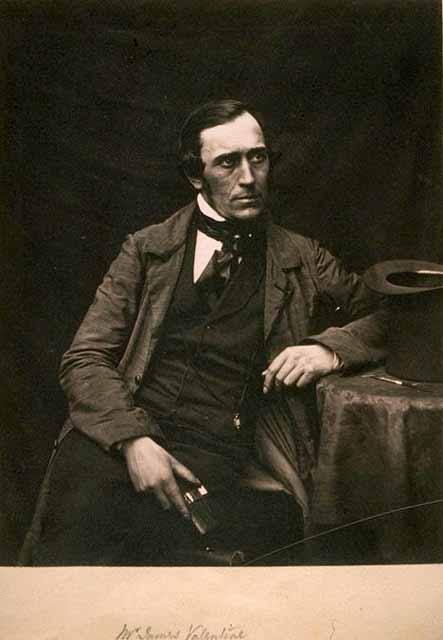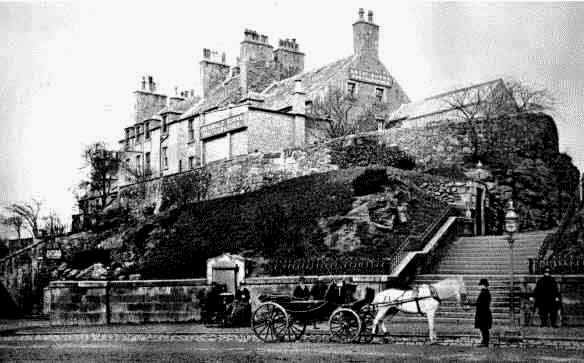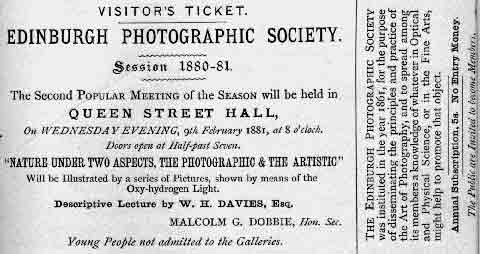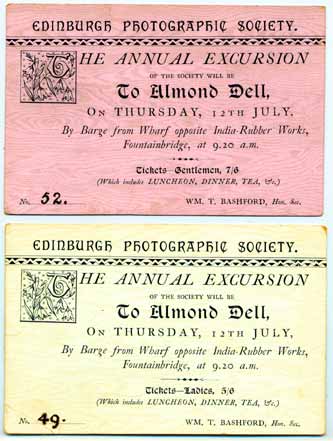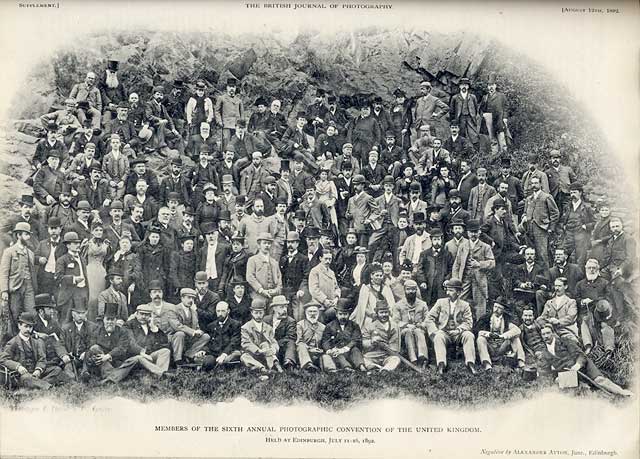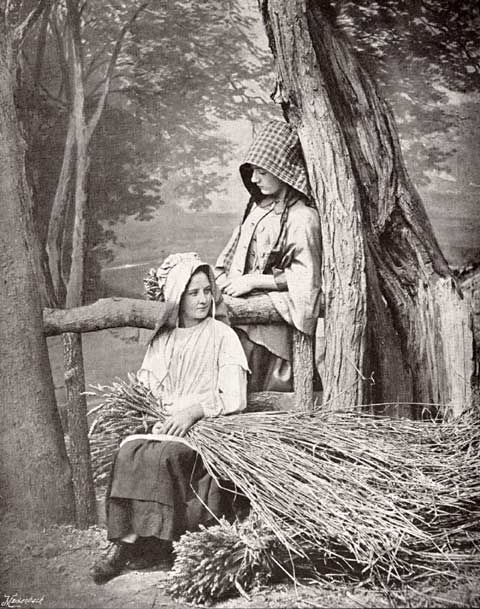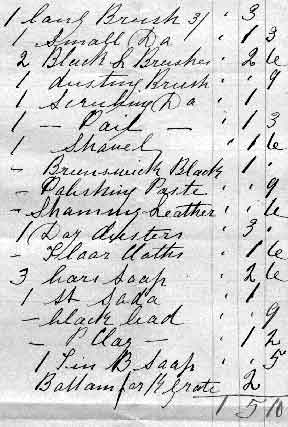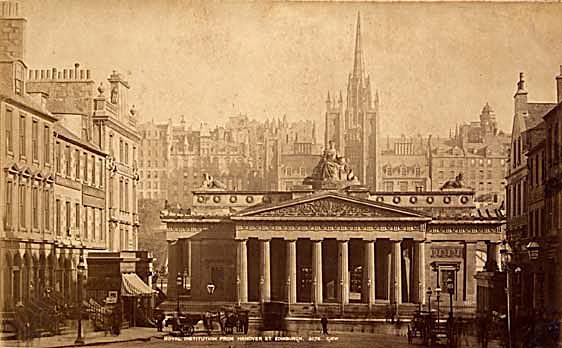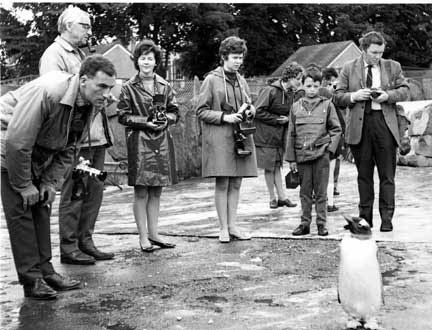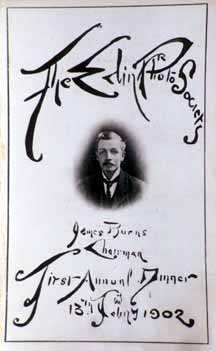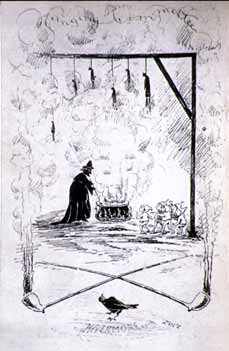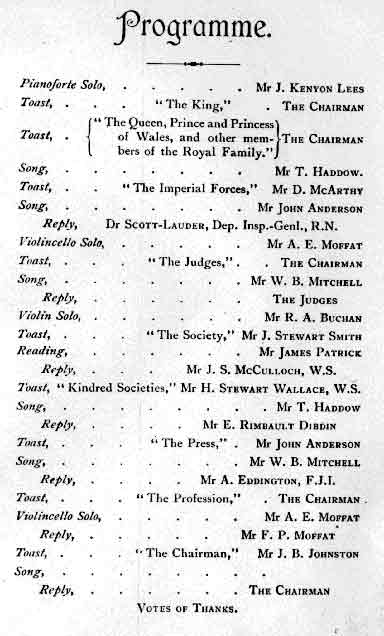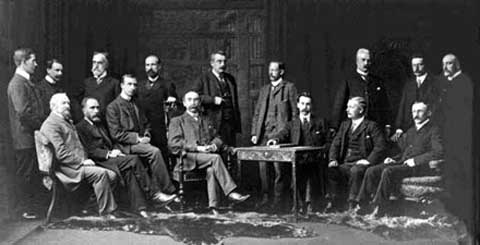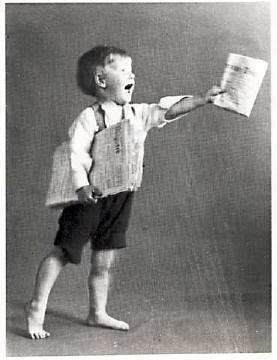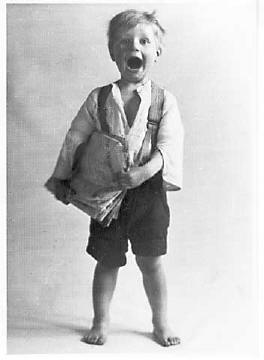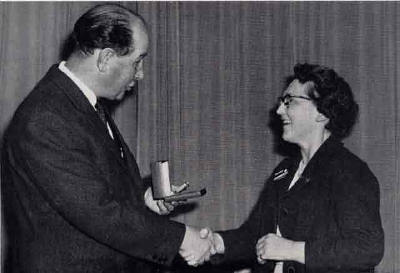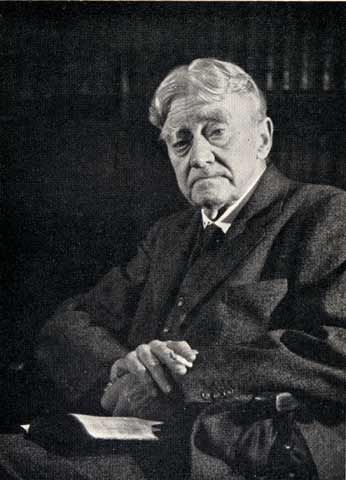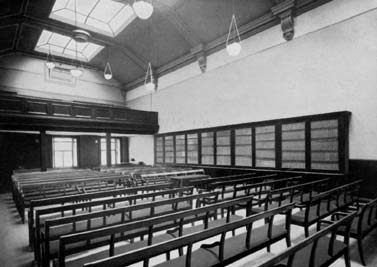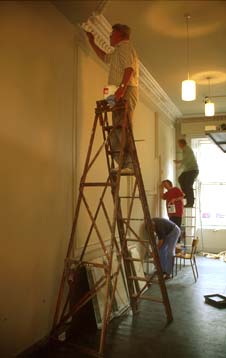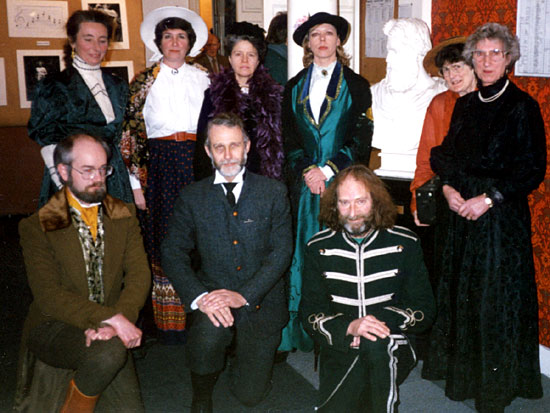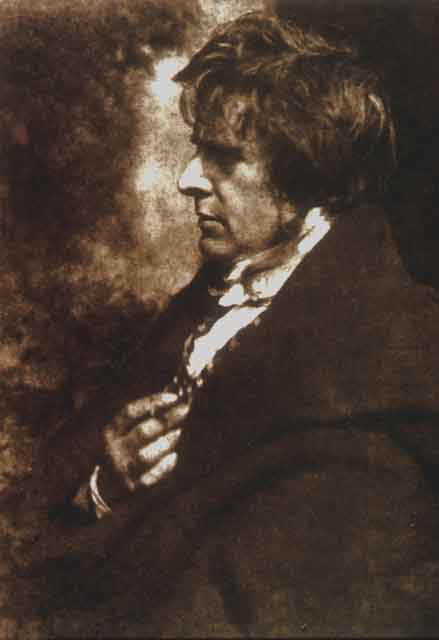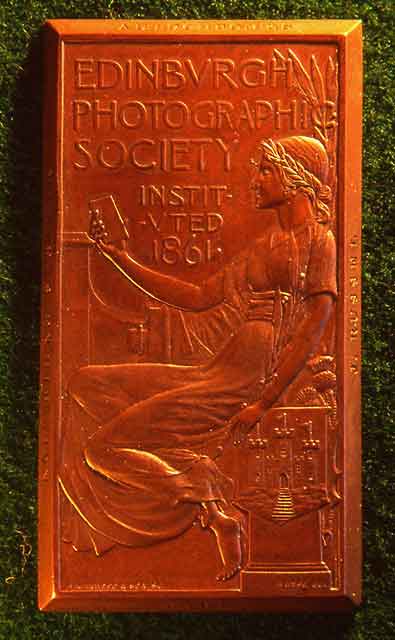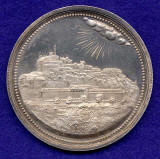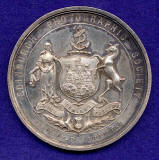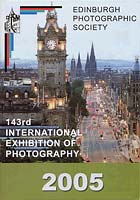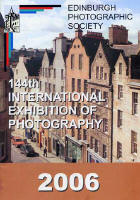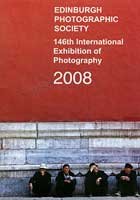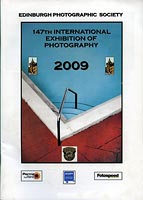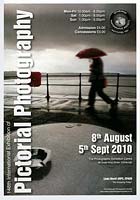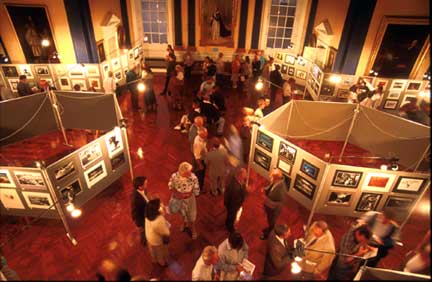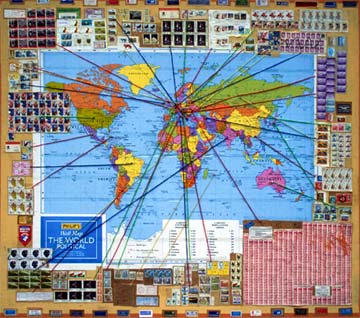|
A Brief History of
Edinburgh
An article to commemorate the 150th Anniversary of EPS |
|
|
Please scroll down this page or click on a link below. |
|
|
Part 1 1861 to 1899 |
Part 2 1900 to 2011 |
|
1. Background 3. Lectures 4. Excursions 5. Membership 6. Premises 7. Exhibitions |
9. Members 10. Premises 12. Exhibitions 13. Poems |
Part 1
1861 to 1899
|
1. Background |
|
1861 In 1861, Abraham Lincoln was elected President of the USA. This was the year that the American Civil War began. In Edinburgh this was the year that the One o’ Clock gun was set up at Edinburgh Castle and the foundation stone was laid for the Royal Scottish Museum in Chamber Street. It was also the year that Edinburgh Photographic Society was founded. |
|
Discovery of Photography Photography had been practiced since 1839, when William Henry Fox Talbot (in England) and Louis-Jacques-Mandé Daguerre (in Paris) had announced their discoveries. William Henry Fox Talbot Photograph by John Moffat, Edinburgh, 1864
©
Reproduced from the National Museum of Photography,
Film and Television collection, However, it was not until The Great Exhibition at Crystal Palace, London, in 1851 that photography had caught the imagination of the wider public and photographic societies began to be established, first in Leeds (1852), then London (1853), Liverpool (1853), Manchester (1855) then the Photographic Society of Scotland (PSS) in Edinburgh (1856). |
|
Photographic Society of Scotland The PSS was founded under the patronage of Prince Albert. The physicist, Sir David Brewster (1781-1868) was President, PSS provided lectures, demonstrations, outings and exhibitions. Its members included both professional and amateur photographers. Sir David Brewster © Reproduced by courtesy of Edinburgh City Libraries and Information Services However, despite its early success, not all members were happy with the PSS. Some found the meetings to be too formal, allowing little scope for discussion. Others objected to a decision to reject the photograph ‘Two Ways of Life’ by the Swedish fine art photographer, Oscar G Rejlander, from the 1857 PSS Exhibition because it included semi-nude female figures. Two Ways of Life - O G Rejlander
© The Royal Photographic Society, Bath, England. web site http://www.rps.org. Rejlander considered his photo to be fine art. The Daily Express argued that the exhibition should have accepted it. ‘The picture was exhibited at the Art Treasures Exhibition in Manchester. Sir David Brewster has a copy of the photo and The Prince Consort has three copies of it.’ |
|
2. Founding of EPS |
|
Founding Members Those dissatisfied with the PSS began to meet informally in Edinburgh, and on 20 February 1861, in a small room behind J Traill Taylor’s watchmaker’s shop at 81 South Bridge, they formally established Edinburgh Photographic Society. J Traill Taylor went on to become the society’s first Secretary. Three years later, he moved to London to become editor of the British Journal of Photography, a post that he held until his death in 1895 (except for seven years spent in the USA). J Traill Taylor © Reproduced by courtesy of Edinburgh Photographic Society James Valentine (1815-79), whose company in Dundee produced photographic views of Scotland, and later postcards, was another founding member, © Reproduced by courtesy of St Andrews University Library as was Archibald Burns (c.1831-80), landscape photographer, whose studio was at Rock House, formerly the home of Edinburgh calotypists, Hill & Adamson. Rock House © Reproduced by courtesy of Edinburgh City Libraries and Information Services |
|
Honorary EPS Members In 1862, EPS elected six honorary members: - Sir William Henry Fox Talbot, inventor and pioneer of photography - Sir David Brewster, Physicist, Principal of St Andrews University - James Sinclair, Earl of Caithness, photographer and exhibitor from London. - Professor Piazzi Smyth, photographer and Astronomer Royal for Scotland. - Dr Lyon Playfair, Professor of Chemistry at Edinburgh University - George Shadbolt, Editor of the British Journal of Photography. |
|
All Members Welcome EPS welcomed all into its membership. Secretary, George H Slight, said in 1867: ‘In a good working society, there should be a thorough admixture of different classes of the community among the members, such as professionals, working amateurs of all ranks, and others calling themselves amateurs who may have only a general hankering after photographic pursuits.’ He said this last class was not to be despised. He referred to them as ‘ornamental members, useful from their position and influence in giving a certain status to a society, and in assisting to augment the funds.’ Professional photographers, as well as amateurs, continued to support the society. EPS Presidents during the 19th century included John Lessels, Frank P Moffat, John Moffat, Alex Ayton and James Patrick. All were prominent professional photographers in Edinburgh. |
|
3. Lectures |
|
Wednesday Meetings In the 1860s, photography involved a lot of experimenting and learning from colleagues, rather than reading Amateur Photographer and camera manuals, so many of the society’s early lectures were instructional. Lecture titles included: - My First Photographic Trip to the Country and what befell me - A New Tent for Photographic Purposes mounted on a Wheelbarrow - The Velocipede as an adjunct to Landscape Photography - Some Recent Explosions and their causes in connection with the Oxyhydrogen Light - The Beer and Albumen Process - Repairing Broken Negatives |
|
Popular Meetings EPS also held a few 'Popular Meetings' each year. These were open to the public, sometimes with up to 1,000 attending. Before the days of cinema and television, viewing slides at an EPS Popular Meeting could provide an evening's entertainment.
© Reproduced by courtesy of Edinburgh Photographic Society Subjects of popular lectures included: - ‘Magic Lantern Slide’ tours of Russia, Italy, Egypt, India, Japan - Views of Scotland, some accompanied by poetry readings and song. |
|
4. Excursions |
|
1870s Cadzow Forrest Here is a photograph taken at one of the EPS Outings in the 1870s. Note the EPS members dressed it top hats! EPS Outing to Cadzow Forest - 1877.
© This photograph is included with National Galleries of Scotland permission. See Copyright Conditions EPS organized photographic excursions to the country by wagonette, train, steamer, canal barge and cycle. The society’s annual picnic was a popular event in the 1870s and 1880s. All the photographic establishments in the city closed for the day. |
|
1870s Almond Dell Here is a report of the 1883 picnic at Almond Dell, possibly taken from the British Journal of Photography: “A party of 109 travelled on a decorated barge with a couple of violins, ‘cello and piano, dances and song. On the outward journey, there was a solo singing competition with seven lady competitors, the prize being a 10” x 8” portrait in carbon of the winner. The bachelors won the tug of war between the married and single. There was music and dancing for 3-4 hours on the barge for the return journey.” Note the price on these tickets for one of the EPS Annual Excursions to Almond Dell by barge: Gentlemen 7/6, Ladies 5/-, to encourage the ladies to attend.
© Reproduced by courtesy of Edinburgh Photographic Society Annual Picnics in other years also included sports. Some of Edinburgh’s better known photographers won prizes for the High Leap, 150 Yard Race, Barrow Race, Hopping Race and Running Backwards Race! |
|
1890s The Photographic Convention of the UK held its Annual Conference in a different location around Britain each year. The convention lasted for a few days and included a wide range of lectures and tours. EPS extended an invitation to the Photographic Convention to hold its 1892 Conference in Edinburgh. The event appeared to have been very successful. Accounts of the week’s events and a photograph of all the participants appeared in the British Journal of Photography. Here is the photo. It was taken in Princes Street Gardens by EPS Professional Photographer, Alex Ayton, who became EPS President in 1894. Photographic Convention of the UK -1892 © Reproduced by courtesy of Edinburgh Photographic Society |
|
5. Membership |
|
Five Shillings The annual EPS membership fee had remained at five shillings (25 pence) from 1861 up to 1892. It then increased to 10s 6d (half a guinea) to include use of darkrooms and other facilities in the newly acquired premises. EPS Membership Cards - 1884-85 © Reproduced by courtesy of Edinburgh Photographic Society Membership of the society expanded. There were 162 members by 1870 and 374 by 1880. The availability of hand-held cameras and dry plates in the 1890s encouraged more people to take up photography and join EPS. By 1900, EPS had 509 members. |
|
Presentation Prints The annual membership fee also entitled for each member to a copy of a Presentation Print every year. Presentation Prints were specially printed, sometimes by the original photographer, for each EPS member from one of the photos exhibited in the previous year’s International Exhibition. Photos by Henry Peach Robinson, George Washington Wilson, James Craig Annan, James Patrick and other highly respected photographers were chosen as Presentation Prints for EPS Members. I wonder how many of these prints have survived today. PSS had previously had a similar scheme of providing Presentation Prints to its members. 'Somebody's Coming'
Silver Medal winning print by HP Robinson
in PSS Exhibition 1864 © Reproduced by courtesy of Edinburgh Photographic Society |
|
Edinburgh Photographic Club Edinburgh Photographic Club (EPC) was established in 1881, with membership limited to 40. Membership was by invitation to some of the more experienced and distinguished members of EPS. The aim, initially, was to act as an upper chamber to discuss the more advanced chemical and physical aspects of photography, but in later years the manufacturers of photographic materials took over this role and EPC became more of a social club. EPC survived for 67 years and is now commemorated by one of the EPS trophies, the EPC Memorial Shield. |
|
6. Premises |
||||||
|
Rented Rooms EPS held its meetings at: - Queen Street Hall, 6 Queen Street (1861-62) - National Bible Society Rooms, 5 St Andrew Square (1863-1885) - Dowell's Rooms, 20 George Street (1885-1892). |
||||||
|
38 North Castle Street Then, in 1892, EPS acquired its own premises at 38 North Castle Street. These premises cost £920 and consisted of ten rooms on three floors, fitted with a library, an enlarging room, and darkrooms with ruby lights for plates and yellow lights for bromide work. EPS Members set about cleaning the premises, spending £1 5s 10d on brushes and other materials for cleaning. Here is the bill for the materials:
The premises at 38 North Castle Street were across the road from No 39, a house that Sir Walter Scott had occupied for many years until he was struck by financial disaster in 1826. |
|
7. Exhibitions |
|
The First Exhibition EPS Exhibitions have been held annually since 1861. The first exhibition was staged when the society was only six weeks old. It attracted some of Britain’s best known photographers, including Fenton, Bedford, Mudd, Rodger, Silvy, and Bison. EPS Exhibitions continued annually during the 19th century, but two in particular stand out. Both were held at the Royal Scottish Academy, Princes Street. Royal Scottish Academy Photo by GW Wilson © Copyright: For permission to reproduce, please contact peter.stubbs@edinphoto.org.uk |
|
Royal Scottish Academy 1876 A major EPS exhibition was held in 1876, occupying the whole Royal Scottish Academy at the foot of the Mound. Six hundred guests were invited to the opening. The society reported: "Copies of a circular had been posted to nearly every photographer in Britain, America, India and the colonies, while the continent had also, so far as practicable, been attended to." The British Journal of Photography reported "Nearly every civilised country was more or less adequately represented in the exhibition’. The exhibition included apparatus, chemicals, books and over 3,000 photos." |
|
Royal Scottish Academy 1890 In this exhibition, there were 1,500 photos on display, including examples of silver prints, carbon, platinum, bromide, Aristotype, Kallitype, Diazotype, vitrified enamel and other processes. Exhibits included early Daguerreotypes, calotypes by Talbot and by Hill & Adamson, and copies of ‘Sun Pictures of Scotland’, ’Pencil of Nature’ and ‘Photographic Drawings’, all by Talbot. Musical entertainment was provided by the String Band of the Queen’s Own Cameron Highlanders, and there were Exhibition Lectures, some illustrated by popular limelight views The exhibition received a lot of favourable press comment. The Practical Photographer described it as "the finest by a long way that has yet appeared in Scotland". |
Part 2
1900 to 2011
|
8. Groups and Meetings |
|
EPS Sports Groups Some groups within the society declined; others started and flourished. The EPS Camera Cycling Corps (estd 1898) survived for only a couple of years, as did the EPS Golf Club (estd 1903). |
|
EPS Popular Meetings There was no longer a demand for Popular Meetings showing lantern slides once the cinematograph had arrived. The final Popular Meeting on 15 March 1901. It comprised: - slides from EPS members shown by lime-light - intervals for concert and music - a cinematograph of an International Rugby Match played at Blackheath on the previous Saturday - a cinematograph of the funeral of Queen Victoria who had died on 22 Jan 1901. |
|
EPS Survey Group The EPS Survey Group had been established in 1899. It worked steadily towards its objective of creating a record of Edinburgh past and present. Photos were taken of many of the streets and buildings in the Old Town. In 1904, the Survey Group staged an exhibition of 50 paintings, 107 engravings and 359 photos. Unfortunately, Survey Group activities were curtailed by the outbreak of war in 1914. However the photos have survived. Some are now in the Scottish National Gallery Collection, some in the Edinburgh City Library Collection and some in the RCAHMS Collection. |
|
Other EPS Groups Other EPS Groups were created during the 20th century: - Portfolio (1916) - Pictorial (1923) - Cine (1927) - Bromoil (1928) - Colour (now re-named Creative) (1955) - Studio (1955) - Colour Printing (1967) - Creative (1973) - Nature (1975) - Audio-visual (1987) - Digital Imaging (1997). Here is a photograph of a Beginners' Portfolio Group Outing to Edinburgh Zoo, around 1964 Beginners' Portfolio Group - c.1964 © Reproduced with acknowledgement to Edinburgh Photographic Society |
|
Wednesday Meetings Wednesday evening has remained the night for the main EPS Meeting. This is a tradition that began in 1861. During the black-outs of World War II, EPS meetings were still held on Wednesdays, but were held monthly, on the Wednesday nearest to the full moon! |
|
9. Members |
||
|
Early 1900s The tradition of holding an Annual Dinner to entertain the judges for the EPS Annual Exhibition was revived in 1902. This tradition continues today. Here are the front and back covers of the menu for the 1902 Annual Dinner:
The cost, excluding wine, for seven courses was five shillings (25p) excluding wine. There were seven courses. Here is the programme for the evening. It includes a good selection of toasts and replies. 1902 Dinner
© Reproduced by courtesy of Edinburgh Photographic Society Here are the EPS Office Bearers the following year. Office Bearers - 1903
© Reproduced by courtesy of Edinburgh Photographic Society |
||
|
Some Prominent Photographers Too many photographers to mention have played important roles in EPS over the years. Amateur photographer, Archibald MacLucas, created some memorable child portraits. Here is a two of his photos of his son, Norman.
Latterly, Archibald MacLucas became known as ‘The Grand Old Man of EPS’, having been EPS President in 1917-18 and 1941-46, and EPS Vice President in 1954. Individual Styles Photographers who have demonstrated their skills in the darkroom include: - Marion Boran who produced some memorable colour prints from black and white negatives - Jim McDougal who experimented with derivative work long before the days of Photoshop - John Robb who delicately retouched his slides using food colouring and was always happy to provide encouragement and advice. Other photographers, including two long serving EPS Office Bearers, have had their own areas of interest and expertise. - It was portrait photography for Gracie Alison, EPS Secretary, 1946-85. She was the first woman and the first Scottish photographer to be elected to the London Salon, and is now commemorated in the annual EPS Memorial Lecture. In the photo below EPS President, George Paterson, presents a gold watch to Gracie 1964, on the occasion of her appointment as Honorary EPS President. Presentation to Gracie Alison - 1964 © Reproduced by courtesy of Edinburgh Photographic Society Here is one of Gracie's portraits. She was awarded the EPS Forbes Adam Cup in the 1949 Members' Exhibition for this portrait. Portrait by Gracie Alison - 1949 © Reproduced by courtesy of Gracie Alison - It was landscape photography for George Cruickshank who was EPS President, 1957-60, and EPS Treasurer for the remainder of the period, 1947-88. - Sandy Cleland, EPS President, 1985-88, an International Photographic Exhibition competitor, organizer and selector and a prominent member of the Royal Photographic Society has shared his nature photography with the society - Philip Caplan has shown some of his creative colour prints, Douglas May has produced panels of contemporary work and Eric Bower has given audio-visual shows and shared his expertise on using Photoshop. Many Members have gained reputations around Scotland and further afield through having their work accepted and winning awards in International Exhibitions. These include Sandy Cleland, Karen Berry, Doug Hamilton, Sue Hill, Eric Bower, Tom Gardner, Neil Scott, Peter Patterson and Richard Bingham. Many others have provided stalwart support to the society over the years. John Ruickbie has resolved many problems with the fabric of the premises. Sue Goode has helped to ensure the smooth running of the prestigious EPS International Exhibition. Both are now Honorary Members of EPS. |
|
10. Premises |
|
38 North Castle Street EPS premises at 38 North Castle Street served the society well, but in later years there were demands for larger premises, preferably with fewer steps to climb. Or, as one member wrote, in verse: "My grievance noo ye’ll quickly guess, I fein would see our E.P.S. In rooms mair flash, no just sae high, Wi mair o’ foreground, and less sky." |
|
Shared Premises So, in 1925, EPS sold 38 North Castle Street and entered into an arrangement with the Royal Scottish Society of Arts (RSSA) for shared use of their premises at 117 George Street. The Large Hall, 117 George Street
© Reproduced by courtesy of Edinburgh Photographic Society The RSSA then moved to 16 Royal Terrace in 1929 and remained there until 1952. 16 Royal Terrace
©
Reproduced by
courtesy of While at 16 Royal Terrace, EPS shared these premises and shared its Journal with the other societies: - Edinburgh Association of Science & Art - Edinburgh Electrical Society - Electrical Association for Women - Edinburgh & District Radio Society. Unfortunately, the RSSA was forced to sell 16 Royal Terrace in 1952, so EPS shared the Edinburgh Cine Club’s premises at Fettes Row for two years before acquiring their own home at 68 Great King Street. |
|
68 Great King Street In 1954, thanks to interest-free loans of £1,055 from members and donations of £120, the society was able to acquire its present premises at 68 Great King Street for £1,650, and spent a further £480 on plumbing, painting, electrical work, and refurbishment. Much of this work was carried out by a band of 50 volunteers and the new premises were formally opened in October 1955. Work at 68 Great King Street was undertaken by members at regular intervals over the next 50 years. Decorating 68 Great ing Street © peter.stubbs@edinphoto.org.uk However, recent decoration and refurbishment has been carried out professionally, culminating in a major refurbishment of the interior of the building in 2009-10. This 1958 report gives some idea of the work being undertaken at the time: “Finally, a source of peril has been removed. Intrepid members who ventured to open that sinister little door marked ‘Danger’ in the darkroom flat, will have found that it plunged directly into Stygian blackness of a sub-basement. The council, in their mercy, have now stretched the funds to the wiring of this, so 'Let there be light'.” |
|
Celebrations Here are some of the EPS Members at 68 Great King Street, with the plaster bust of D O Hill in the background, celebrating the EPS 125th Anniversary in 1986. EPS 125th Anniversary © Reproduced with acknowledgement to Sue Hill, EPS |
|
11. Photographic Collection |
|
1861 By 1980, the society had built up a large valuable collection of photos and equipment. At one time there were plans to create an EPS Museum, but this never materialised. Storage conditions for prints at the premises were not ideal, and three floods from burst pipes in the flat above during 1979 and 1980 did not help the situation. So, in 1987, many of the photos were donated to the Scottish National Portrait Gallery. This collection of photos included many calotypes from the Hill & Adamson partnership 1843-47. Just one of the Hill & Adamson photos has remained in the possession of EPS. Here it is: D O Hill © Reproduced by courtesy of Edinburgh Photographic Society In 1990, the Scottish National Portrait Gallery staged an exhibition based on the Hill & Adamson calotypes donated to the gallery by EPS. |
|
12. Exhibition |
|
Medals Here is a similar medal that was awarded to J Russel for his autochrome image, exhibited in the EPS Members' Exhibition, 1914. © Copyright: For permission to reproduce, please contact peter.stubbs@edinphoto.org.uk This is the style of medal now being awarded by EPS. It is based on an old die from the 19th century. © Reproduced with acknowledgement to Edinburgh Photogrpahic Society Here is one, in silver. It was awarded to JB Johnson in the EPS Open Exhibition, 1896. © David Likar, Australia
|
|
Catalogues EPS International Exhibitions and Members’ Exhibitions of Photography have continued to be held annually. 1920s Catalogue © Reproduced by courtesy of Edinburgh Photographic Society Since 1949, the International Exhibition has been held in August, during the Edinburgh Festival. Venues have included YMCA Exhibition Hall, then St Cuthbert’s Hall, then Merchant’s Hall, then since 1996, EPS premises at 68 Great King Street. Here are the covers of some of the recent exhibition catalogues. Recent Catalogue Covers © All catalogues above to 2007:: Edinburgh Photographic Society |
|
Recent Exhibitions The number of International Print Exhibitions around the world has reduced in recent years, as some societies have had difficulty in finding the resources to stage them. However, our exhibition continues to be staged and remains highly regarded. Only a small percentage of entries is accepted each year, so gaining an acceptance is regarded as an achievement. EPS International Exhibition at Merchants' Hall - 1995
© Copyright: For permission to reproduce, please contact peter.stubbs@edinphoto.org.uk Since the 1950s, EPS International Exhibitions have attracted entries from 130 countries, typically between 1,200 and 4,000 entries pa, from which about 200 have been selected and exhibited. Entries from Around the World
© please contact peter.stubbs@edinphoto.org.uk |
|
13. Poems |
|
PSS When the Photographic Society of Scotland held its first exhibition in Edinburgh in 1856-7, there was still a novelty in viewing photos. The press enthused abut the exhibition, describing photos as ‘paintings made by the sun, 'Old Sol’. The Courant newspaper published this poem about the exhibition: APOLLO AGAINST THE ARTISTS "I also am a painter!" was said, as all men know And said by no mean artist, three centuries ago. But lo! An artist greater far among us now appears; For after shining quietly on for twice three thousand years Old Sol takes up his parable, and says - "I've now on view Some pictures that, perhaps, may show that I'm an artist too." "If any man shall doubt the fact, let him proceed straightway To my Great Exhibition-Room and there his shilling pay. I think I there may promise him his shilling's worth and more In Portraits such as mortal eye ne'er looked upon before; In Temples and in Palaces - in scenes by land and sea - For nothing that I shine upon can come amiss to me!" "Old Sol had scarcely spoken thus, when forth I went straightway To his Great Exhibition-Room, my shilling there to pay. And scarcely had I passed the door, and laid my money down When I exclaimed 'A shilling's worth! Why this is worth a crown. He really is a painter! His own account is true. I only wish we saw him here far oft'ner than we do'." The Courant 22 January 1857] A few days later, the Daily Scotsman printed another poem about the exhibition: TEMPLE OF THE SUN A street must always some respect from loyal subjects claim Which from the House of Hanover derives its honoured name. But even such a favoured street acquires a new renown, And gives a brighter lustre to that corner of the town. When day by day both grave and gay are thither seen to run With eager anxious haste to seek the Temple of the Sun. "The Temple of the Sun!" (you say) "why, what may these words mean? "We're surely not fire worshippers nor have we ever been; "We do not, like the Magi, feed the ever-flaming pyre, "Although we all delight to stir a jolly Christmas fire; "We all revere the weather clear, the worthy god of day, "But not in an idolatrous or heathen sort of way!" All this, no doubt, may be most true, but come along with me, And in the street of Hanover, you’ll see what you shall see; We need not quarrel about words, not take the pedant's tone, But only come along with me and you at once will own There ne'er have been such marvels seen, in either street or square As Phœbus shows his worshippers at number Sixty there. Daily Scotsman: Jan 31, 1857 |
|
EPS Poems and songs continued to feature in EPS Bulletins and Journals for the next 150 years, some of the most memorable being poems in Scots by former EPS Secretary, Douglas Fraser and songs in the style of Gilbert & Sullivan by EPS Member, KoKo. We finish with a couple written by EPS members: CAPTAIN OF THE EPS "When I was a lad with a smile so sweet I took a little walk along Great King Street I moved the chairs and I swept the floor And I polished up the handle on the big front door. I polished up the handle with such finesse That now I am the captain of the E P S. I went again and they said to me You’re just the sort of fellow who can make the tea I made the tea, no-one asked for more, It tasted like you’ve never tasted tea before. I poured that tea like a good hostess And now I am the captain of the E P S. I went once more and a voice said “You” We’ve got another little job for you to do If they come late, you let them in The ringing of the bell, it makes an awful din. I opened the door with such success That now I am the captain of the E P S. I entered a print, I entered a slide And when I heard the judge I had to go outside. You could trim this here, you could burn this in But I think you’d better put it in the refuse bin.” He thought my pictures were quite useless That’s why they made me captain of the E P S So if you make tea, and sweep the floor, And polish up the handle on the big front door - If you do this and you do that And stay behind for tea and have a little chat, If you take pictures without success Then you all may be captains of the EPS “Ko-ko”
Sung by Brian
Covell at the President’s Evening, 1990 EDINBURGH PHOTOGRAPHIC SOCIETY "With mingled feelings I recall those days when forth I hied, A novice, with my half-plate in a satchel by my side; Resolved on “taking” somebody, or something, you may guess, But lackaday! I knew not then the good old EPS. To drive the crowd of urchins back, who gather quite in force Upset one, and the dark side I forgot to draw, of course; And ofttimes two exposures on one plate (which is excess) Produced effects more wonderful than charming, I confess. Sometimes the cap I would forget still firm upon the hood, While I with air of one who knows, (but inward trembling) stood; And, watch in hand, the rubber ball, most deftly I would press, Then came a glad expectant dream - words cannot here express ’Twas in the darkroom, vivid thoughts of latent gems would rise And phantom landscapes oft beguiled one’s weary, watchful eyes; Till roused by some home critic -“What a horrid splashy mess! Why don’t you learn from others - Go and join the EPS.” On progress bent, with firm resolve, and by a friend proposed, I proudly was admitted mem. con. (that is, unopposed); Now, while I live, I surely that auspicious day shall bless, When I became a member of the good old EPS. Here genial, kindred spirits one can meet with by the way And all his wrongs have righted, and made clear as an X-ray; Those little peccadilloes need no longer now distress, For everything goes smiling when you join the EPS. So now, I sally fort, rare gems to gather as I go, And e’en have ventured to exhibit at the Photo Show; Success has crowned my efforts. If you’ll call at my address, You there can see my trophy - Bronze Medallion EPS. Karr Bonne, 1902 |
|
Edinburgh Photographic Society History |
||
|
For news of EPS today, please click here to view the EPS web site |
||
